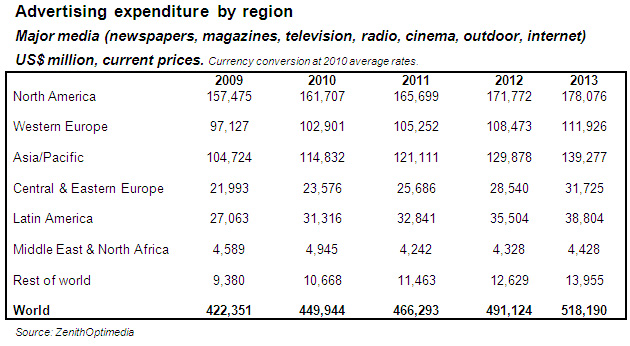 ZenithOptimedia has made a small reduction to its forecast for global ad expenditure growth in 2011 to 3.6%, which is 0.5 percentage points less than the forecast it made in July.
The slowdown in economic recovery in the developed markets, coupled with rising fears of double-dip recession, have caused some advertisers to trim back budget increases planned for the end of 2011, but there has been no sign of the cancelled campaigns and sharp budget cuts that signalled the beginning of the last advertising downturn in 2008. We now expect total ad expenditure to reach US$466 billion in 2011, up from US$450 billion in 2010.
We have made a similar reduction to our growth forecast for 2012: from 5.9% to 5.3%, still a reassuringly healthy rate. 2012 is a ‘quadrennial’ year and will benefit from the summer Olympics in the UK, the European Football Championship in Poland and Ukraine, and the Presidential elections in the US. The growth rate will also be boosted by Japan’s recovery from the earthquake in March, which severely disrupted media and advertising for several weeks this year. We estimate that the quadrennial effect will add US$6.2 billion to the global ad market in 2012, and the Japanese recovery another US$0.8 billion.
Our new forecast for 2013 is barely changed at 5.5%, down from 5.6% in July.
Soon after we published our last forecast in early July, financial markets fell sharply across the world, and they have been extremely volatile since then. The Dow Jones Industrial Average fell 12.7% between July 21 and August 10; the Hang Seng fell 14.7% between August 1 and August 9, and the Nikkei 225 fell 13.4% between August 1 and August 22. This has naturally created concern that the ad market may be headed for another downturn. However, stock market shocks are not by themselves good indicators of ad market decline. There have been many cases when stock market crashes have been followed by continued growth in ad expenditure.
ZenithOptimedia has a database of ad expenditure figures for 79 markets going back 31 years. We looked at 12 dramatic stock market crashes around the world over this period to examine their effects on ad expenditure. In some cases big declines in stock market values were followed by downturns in ad expenditure the next year, notably after the Asian financial crisis of 1997 and the bursting of the dotcom bubble in 2000.
However, the ‘Black Monday’ crash of 1987 caused no slowdown in the most-affected markets – in fact growth was faster in 1988 than 1987 in Canada, the UK and the US. The Asian financial crisis did not prevent ad expenditure growing in Hong Kong in 1998 (though growth was slower than in 1997), and it had no effect on advertising in the US. And the sharp drop in the DJIA in the US after September 11 did not prevent the recovery of growth in 2002, though growth remained weak. In all, half of the stock market crashes preceded an advertising downturn, but half did not.
A crash in stock market values does not by itself mean ad expenditure is about to decline – there needs to be a causal connection between the two. This connection can either be that an overvalued stock market is supporting excessive advertising (as was the case in 2000), or that the market correctly anticipates a sharp downturn in global economic activity.
Advertising expenditure grew rapidly from 0.96% of GDP in 1998 to 1.05% in 2000. As the dotcom bubble inflated, start-ups funnelled money raised from venture capital firms and IPOs to the ad market in the name of brand building. When the bubble burst, ad expenditure fell sharply. Since then there has been no build up of excessive advertising – in fact, advertisers are spending just 0.73% of GDP, less than at any time since at least 1980. This is partly because of the rising contribution from developing markets, where advertising typically accounts for a much lower proportion of GDP. For example in China, now the world’s third-largest ad market, advertising accounts for only 0.44% of GDP, highlighting the potential for long-term growth as this proportion approaches the world average.
There is certainly a risk of further economic downturn ahead, but the current consensus is that the developed economies face a sustained period of below-potential growth instead of decline, while developing markets will continue to grow rapidly, if at a cooler pace than in 2010. Our forecasts assume that economic growth remains weak in Europe and the US, but neither goes into double-dip recession, and the Eurozone debt crisis does not get substantially worse.
Developing markets, in general, continue to expand far faster than developed markets, driven by their much faster economic growth. We forecast North America to grow by an average of 3.3% a year between 2010 and 2013 and Western Europe to grow by 2.8%. These regions have reversed positions since our previous forecast, when we expected Western Europe to outperform North America with 3.4% growth to North America’s 3.1%. The continuing debt crisis in the peripheral Eurozone has damaged advertisers’ confidence in Western Europe’s long-term growth prospects. We expect Japan to grow an average of just 1.1% a year, after a big drop in 2011 followed by the recovery of lost ground over the next two years.
By sharp contrast we forecast Latin America to grow by 7.1% a year between 2010 and 2013, Asia Pacific excluding Japan to grow by 10.1%, and Central & Eastern Europe to grow by 10.4%. The exception is the Middle East and North Africa, where political turmoil has disrupted media production and distribution, and made advertisers wary of attracting negative attention. We forecast a 14.2% decline in ad expenditure in 2011, followed by very modest recovery of 2.0% in 2012 and 2.3% in 2013, averaging 3.6% decline between 2010 and 2013. The global impact of this will be limited by the fact that the Middle East and North Africa accounts for just 1% of global spend. Overall we expect developing markets – which we here define as everywhere outside North America, Western Europe and Japan – to increase their share of the global ad market from 31.0% in 2010 to 34.9% in 2013.
There are now two ‘developing’ markets in the world’s top ten ad markets, and there will be three in 2013. China is now the third-largest ad market in the world, and is catching up quickly with second-placed Japan. In 2005 China was 23% of the size of Japan, in 2010 it was 57% and by 2013 we predict it to be 82%. Brazil, at sixth place, is even closer to the UK: 81% of the size of the UK in 2010 and will be 89% in 2013. Russia, which was in 13th place in 2010, will be in tenth in 2013.
ZenithOptimedia has made a small reduction to its forecast for global ad expenditure growth in 2011 to 3.6%, which is 0.5 percentage points less than the forecast it made in July.
The slowdown in economic recovery in the developed markets, coupled with rising fears of double-dip recession, have caused some advertisers to trim back budget increases planned for the end of 2011, but there has been no sign of the cancelled campaigns and sharp budget cuts that signalled the beginning of the last advertising downturn in 2008. We now expect total ad expenditure to reach US$466 billion in 2011, up from US$450 billion in 2010.
We have made a similar reduction to our growth forecast for 2012: from 5.9% to 5.3%, still a reassuringly healthy rate. 2012 is a ‘quadrennial’ year and will benefit from the summer Olympics in the UK, the European Football Championship in Poland and Ukraine, and the Presidential elections in the US. The growth rate will also be boosted by Japan’s recovery from the earthquake in March, which severely disrupted media and advertising for several weeks this year. We estimate that the quadrennial effect will add US$6.2 billion to the global ad market in 2012, and the Japanese recovery another US$0.8 billion.
Our new forecast for 2013 is barely changed at 5.5%, down from 5.6% in July.
Soon after we published our last forecast in early July, financial markets fell sharply across the world, and they have been extremely volatile since then. The Dow Jones Industrial Average fell 12.7% between July 21 and August 10; the Hang Seng fell 14.7% between August 1 and August 9, and the Nikkei 225 fell 13.4% between August 1 and August 22. This has naturally created concern that the ad market may be headed for another downturn. However, stock market shocks are not by themselves good indicators of ad market decline. There have been many cases when stock market crashes have been followed by continued growth in ad expenditure.
ZenithOptimedia has a database of ad expenditure figures for 79 markets going back 31 years. We looked at 12 dramatic stock market crashes around the world over this period to examine their effects on ad expenditure. In some cases big declines in stock market values were followed by downturns in ad expenditure the next year, notably after the Asian financial crisis of 1997 and the bursting of the dotcom bubble in 2000.
However, the ‘Black Monday’ crash of 1987 caused no slowdown in the most-affected markets – in fact growth was faster in 1988 than 1987 in Canada, the UK and the US. The Asian financial crisis did not prevent ad expenditure growing in Hong Kong in 1998 (though growth was slower than in 1997), and it had no effect on advertising in the US. And the sharp drop in the DJIA in the US after September 11 did not prevent the recovery of growth in 2002, though growth remained weak. In all, half of the stock market crashes preceded an advertising downturn, but half did not.
A crash in stock market values does not by itself mean ad expenditure is about to decline – there needs to be a causal connection between the two. This connection can either be that an overvalued stock market is supporting excessive advertising (as was the case in 2000), or that the market correctly anticipates a sharp downturn in global economic activity.
Advertising expenditure grew rapidly from 0.96% of GDP in 1998 to 1.05% in 2000. As the dotcom bubble inflated, start-ups funnelled money raised from venture capital firms and IPOs to the ad market in the name of brand building. When the bubble burst, ad expenditure fell sharply. Since then there has been no build up of excessive advertising – in fact, advertisers are spending just 0.73% of GDP, less than at any time since at least 1980. This is partly because of the rising contribution from developing markets, where advertising typically accounts for a much lower proportion of GDP. For example in China, now the world’s third-largest ad market, advertising accounts for only 0.44% of GDP, highlighting the potential for long-term growth as this proportion approaches the world average.
There is certainly a risk of further economic downturn ahead, but the current consensus is that the developed economies face a sustained period of below-potential growth instead of decline, while developing markets will continue to grow rapidly, if at a cooler pace than in 2010. Our forecasts assume that economic growth remains weak in Europe and the US, but neither goes into double-dip recession, and the Eurozone debt crisis does not get substantially worse.
Developing markets, in general, continue to expand far faster than developed markets, driven by their much faster economic growth. We forecast North America to grow by an average of 3.3% a year between 2010 and 2013 and Western Europe to grow by 2.8%. These regions have reversed positions since our previous forecast, when we expected Western Europe to outperform North America with 3.4% growth to North America’s 3.1%. The continuing debt crisis in the peripheral Eurozone has damaged advertisers’ confidence in Western Europe’s long-term growth prospects. We expect Japan to grow an average of just 1.1% a year, after a big drop in 2011 followed by the recovery of lost ground over the next two years.
By sharp contrast we forecast Latin America to grow by 7.1% a year between 2010 and 2013, Asia Pacific excluding Japan to grow by 10.1%, and Central & Eastern Europe to grow by 10.4%. The exception is the Middle East and North Africa, where political turmoil has disrupted media production and distribution, and made advertisers wary of attracting negative attention. We forecast a 14.2% decline in ad expenditure in 2011, followed by very modest recovery of 2.0% in 2012 and 2.3% in 2013, averaging 3.6% decline between 2010 and 2013. The global impact of this will be limited by the fact that the Middle East and North Africa accounts for just 1% of global spend. Overall we expect developing markets – which we here define as everywhere outside North America, Western Europe and Japan – to increase their share of the global ad market from 31.0% in 2010 to 34.9% in 2013.
There are now two ‘developing’ markets in the world’s top ten ad markets, and there will be three in 2013. China is now the third-largest ad market in the world, and is catching up quickly with second-placed Japan. In 2005 China was 23% of the size of Japan, in 2010 it was 57% and by 2013 we predict it to be 82%. Brazil, at sixth place, is even closer to the UK: 81% of the size of the UK in 2010 and will be 89% in 2013. Russia, which was in 13th place in 2010, will be in tenth in 2013.
 The sheer size of the US – 3.3 times the next-largest market – means it will contribute the most new ad dollars to the global market over the next three years (US$14.3 billion), despite its slow growth. However, the next five largest contributors are all developing markets: China (which contributes almost as much as the US, US$12.7 billion), Russia (US$4.7 billion), Brazil (US$2.9 billion), India (US$2.6 billion) and Indonesia (US$2.5 billion). Overall we predict developing markets will contribute 59% of new ad dollars over the next three years.
The sheer size of the US – 3.3 times the next-largest market – means it will contribute the most new ad dollars to the global market over the next three years (US$14.3 billion), despite its slow growth. However, the next five largest contributors are all developing markets: China (which contributes almost as much as the US, US$12.7 billion), Russia (US$4.7 billion), Brazil (US$2.9 billion), India (US$2.6 billion) and Indonesia (US$2.5 billion). Overall we predict developing markets will contribute 59% of new ad dollars over the next three years.


 Global advertising expenditure by medium
As usual, the internet is growing much faster than any other medium, at an average of 14.6% a year between 2010 and 2013. Display is the fastest-growing segment, growing by 17.2% a year, driven mainly by online video and social media. Streaming video ads are growing extremely quickly, thanks to the emergence of do-it-yourself tools that have allowed local advertisers to enter the market. In most developed markets, social media sites are near the top of the list of most-popular websites, and they are often way ahead of their rivals in time spent by users. Other display publishers are developing new tools and formats to compete with social media sites. Paid search is growing by 14.6% a year, but its growth is being slightly restrained by the shift in search behaviour from desktop to mobile devices, where costs are currently lower. Online classified is growing relatively slowly, by 9.2% a year, while employment and property markets remain weak in the biggest countries. Overall, we predict internet advertising will increase its share of the ad market from 14.4% in 2010 to 18.9% in 2013, when it will overtake newspapers to become the world’s second-largest medium.
The main contributor to global ad growth, however, is television, which we forecast to account for 46% of new ad dollars between 2010 and 2013. Television’s share of the global ad market has risen steadily over time: it attracted 39.8% of spend in 2010, up from 37.0% in 2005, and we forecast it to attract 40.5% in 2013. The amount of time viewers spend watching television continues to increase, and even though viewers are presented with a wider choice of channels than ever, the biggest television events are attracting record audiences. This year’s Super Bowl, for example, was watched by 111 million Americans, making it the most watched broadcast in US history. It beat the previous year, itself a record breaker, by 4.2%.
Newspapers and magazines have been declining since 2007, with a brief pause for magazines in 2010, when ad expenditure remained essentially static. We expect this decline to continue throughout our forecast period. Magazines are suffering less than newspapers, because the experience of reading a magazine is less easy to replicate online, and because they do not rely so much on the timely delivery of information, where the internet has a big advantage over newspapers. We predict magazine ad expenditure will shrink by 0.6% a year over our forecast period, while newspaper ad expenditure shrinks by 1.4%. In 2013 newspapers will fall behind the internet into third place, with a 17.9% share of spend.
Global advertising expenditure by medium
As usual, the internet is growing much faster than any other medium, at an average of 14.6% a year between 2010 and 2013. Display is the fastest-growing segment, growing by 17.2% a year, driven mainly by online video and social media. Streaming video ads are growing extremely quickly, thanks to the emergence of do-it-yourself tools that have allowed local advertisers to enter the market. In most developed markets, social media sites are near the top of the list of most-popular websites, and they are often way ahead of their rivals in time spent by users. Other display publishers are developing new tools and formats to compete with social media sites. Paid search is growing by 14.6% a year, but its growth is being slightly restrained by the shift in search behaviour from desktop to mobile devices, where costs are currently lower. Online classified is growing relatively slowly, by 9.2% a year, while employment and property markets remain weak in the biggest countries. Overall, we predict internet advertising will increase its share of the ad market from 14.4% in 2010 to 18.9% in 2013, when it will overtake newspapers to become the world’s second-largest medium.
The main contributor to global ad growth, however, is television, which we forecast to account for 46% of new ad dollars between 2010 and 2013. Television’s share of the global ad market has risen steadily over time: it attracted 39.8% of spend in 2010, up from 37.0% in 2005, and we forecast it to attract 40.5% in 2013. The amount of time viewers spend watching television continues to increase, and even though viewers are presented with a wider choice of channels than ever, the biggest television events are attracting record audiences. This year’s Super Bowl, for example, was watched by 111 million Americans, making it the most watched broadcast in US history. It beat the previous year, itself a record breaker, by 4.2%.
Newspapers and magazines have been declining since 2007, with a brief pause for magazines in 2010, when ad expenditure remained essentially static. We expect this decline to continue throughout our forecast period. Magazines are suffering less than newspapers, because the experience of reading a magazine is less easy to replicate online, and because they do not rely so much on the timely delivery of information, where the internet has a big advantage over newspapers. We predict magazine ad expenditure will shrink by 0.6% a year over our forecast period, while newspaper ad expenditure shrinks by 1.4%. In 2013 newspapers will fall behind the internet into third place, with a 17.9% share of spend.

相关推荐换一批
- loading...
-

AKQA
-

上海宝尊电子商务有限公司
宝尊电商成立于2007年初,提供以品牌电子商务为核心的全链路一站式商业解决方案,涉及店站运营、数字营销、IT解决方案、仓储配送、客户服务等5大内容。 宝尊电商始终坚持:以科技创新和客户需求为引擎,致力成为全球品牌电商4I商业伙伴。
-

柠川文化
柠萌影业旗下成立的全资子公司
-

华扬联众
华扬联众Hylink 是以驱动增长为核心、整合全渠道营销的信息技术服务公司
-

Interbrand
Interbrand是⼀家国际领先的综合性品牌战略顾问和设计公司,拥有管理咨询公司的严谨策略和分析技巧,同时也具备极富创意的品牌推⼴及设计优势。Interbrand为客户提供全⽅位的品牌咨询服务为他们创造和管理企业和产品的品牌价值。
-

FCB 博达大桥
-

前线网络 Front Networks

















